Shuttle XPC ST20G5
Overview
We've already covered the G5 chassis with our talk of the SN95G5, so there isn't a whole lot to say about the ST20G5. The basic idea is to take the same chassis and swap out the nForce 3 Ultra chipset and motherboard for a board that uses the ATI Xpress 200 chipset with a ULi 1573 South Bridge. Most areas remain the same, so we'll focus on the differences.Something that we would like to mention is that Shuttle now offers complete SFF systems through their online store as well as a variety of retail outlets. We've seen them at Best Buy, for example, although the local branch only carried an older Athlon XP model. Originally, the Shuttle XPCs were sold as a bare-bones system: case, motherboard, and power supply. Starting in 2004, Shuttle began offering complete systems. While you sacrifice some customization options, it does provide a ready-to-use alternative with a Shuttle warranty. Many of the upgrades end up costing quite a bit, but we see that for most companies that offer pre-configured systems. Those who do not want to build their own system can find more details at the Shuttle web site.
Aesthetics
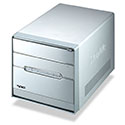 |
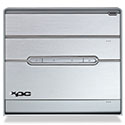 |
| Click on images to enlarge. | |
In terms of appearance, the ST20G5 is the exact same as the SN95G5 with one exception. Instead of a black anodized aluminum finish, the case is silver brushed aluminum. We don't have particularly strong feelings one way or the other, as they are both attractive. If you prefer silver over black, the ST20G5 meets that need. In an ideal world, users would be able to get whatever color case they wanted with any of the various models, but the reality is that getting a non-standard color will usually cost extra.
Features
|
Shuttle XPC ST20G5
|
||
| Dimensions | (w)200 mm x (h)185 mm x (d)310 mm | |
| CPU Support | AMD Socket 939 up to FX-57 X2 support currently Beta |
|
| Memory Support | PC1600/PC2100/PC2700/PC3200 up to 2GB; 2 DIMM slots | |
| Motherboard | FT20 (proprietary) ATI Radeon Xpress 200 (Northbridge) ULi 1573 (Southbridge) 1X-5X (200-1000MHz) HyperTransport 8-bit/8-bit to 16-bit/16-bit HT Width |
|
| Expansion Slots | 1 x PCIe X16; 1 x PCI | |
| Power Supply | 240W Silent X Power Supply 2 x 4-pin Molex; 1 x 4-pin FDD; 3 x SATA 1 x 4-pin ATX12V; 1 x 20-pin ATX |
|
| Internal Connections | 2 x SATA; 1 x IDE; 1 x FDD; 1 x LPT | |
| Audio | Realtek ALC880 7.1 channel HD | |
| LAN | 1 x 10/100/1000 Mbps (Broadcom PCIe) | |
| Drive Bays | 1 x 3.5 External (FDD/HDD) 1 x 3.5 Internal (HDD) 1 x 5.25 External (CD/DVD) |
|
| Front I/O | 2 x USB 2.0 1 x IEEE1394 (4pin) MIC, Head-phone Power & Reset buttons Power on & HDD LED indicators |
|
| Rear I/O |
1 x DVI, 1 x VGA 2 x USB 2.0 1 x IEEE1394 (6pin) PS/2 KB, PS/2 Mouse Serial port RJ-45 LAN Port (10/100/1000Mbps) S/PDIF In/Out Optical ports Line-in, Center/Sub, L/R Front, L/R Side, L/R Rear |
|
| Overclocking | CPU 200-255; CPU Ratio 4X-Max; Northbridge 1.60V-1.70V Vcc 0.800-1.700V; DDR Auto, 2.70-2.90V |
|
| Extras | ICE cooling | |
| Full Image Set | Shuttle ST20G5 Pictures (6.0MB) | |
| Manufacturer Link | Shuttle XPC ST20G5 | |
The feature list of the ST20G5 is similar to the SN95G5, with the obvious exception of the integrated graphics and PCI Express. Firewire, USB, GbE, audio, and S/PDIF are all present and accounted for. Internally, the layout is different and some of the features come from a different source (i.e. the network chip), but the basics remain the same. There are two DIMM slots, a PCIe X16 and PCI slot, two SATA and IDE connections, and a floppy connection. As usual, the G5 case includes two 3.5" drive bays, one internal and one external, along with a single external 5.25" bay up top.
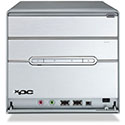 |
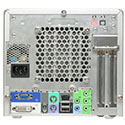 |
| Click on images to enlarge. | |
Let's talk a bit more about the differences, though. Where the nForce 3 Ultra powers the SN95G5 and provides a single chip solution, the ST20G5 uses a more traditional North Bridge/South Bridge arrangement. The ATI Xpress 200 is the NB and provides the PCI Express interface as well as a HyperTransport connection to the processor. For the SB, a ULi M1573 is used and it includes audio, USB, network, IDE/SATA, and PCI support. A PCI Express interface is used to connect to the NB, which helps to save on costs, since the NB already includes PCIe support. While the ULi chip includes a network controller, it is limited to 10/100 Mbit functionality and Shuttle has instead chosen to include a Broadcom GbE model. The Broadcom chip runs on the PCI Express bus (with an X1 interface), making it potentially faster than PCI GbE. We'll see how it compares later. The other major difference is that the ST20G5 uses PCI Express graphics like the SN25P, and here, we feel that the ST20G5 is the best configuration from Shuttle as it includes a PCIe X16 slot along with a standard PCI slot. In the future, X1 PCIe devices may become common, but right now, such slots go unused.
The integrated graphics are rather impressive, compared to competing solutions. Not only are they fully DirectX 9 compliant (with Shader Model 2.0 support), but they include a first for any integrated graphics that we've used: DVI output! Why does this matter? If you're interested in a SFF case for its looks, an LCD is a logical companion device. LCDs really aren't meant to be run with an analog VGA connection, as it results in poorer image quality. With the ATI Radeon Xpress 200 IGP, you get both the VGA connection as well as a DVI connection. DVI is also useful for connecting many HDTV displays to a computer. In our use, the TV was properly detected as a 1080i device. Unfortunately, it would only run at 1080i using the DVI connection. This is an ATI driver issue, as NVIDIA manages to support other resolutions (like 720p) through the DVI connection without any problem. We have heard from ATI that this will be addressed in an upcoming Catalyst release (5.7 may have already fixed this - we will check when we test the X2 chip).
Another interesting feature of the IGP is that it can be used concurrently with an add-in graphics card - although this only works with ATI models, as far as we're aware. ATI dubs this feature "Surround View" and it gives users the option of driving up to four separate display devices at the same time - two via the IGP and two via a supported add-in card. We're not sure how many people would actually purchase a SFF case with that intent, but the option is there should you need it. In the end, the Xpress 200 is the current leader in IGP solutions and offers much improved flexibility. Kudos goes to ATI for increasing IGP performance, and props to Shuttle for taking full advantage of the chipset.
The audio provided on the ST20G5 looks good on paper, and we're happy to see an HD solution (provided by the ULi chipset and a Realtek AL880 codec). This allows for 7.1 audio support, and though we think that 5.1 audio is more than sufficient, the additional audio ports do allow you to run 5.1 along with a microphone/line-in device. As with the SN95G5, all of the audio-out plugs are framed in the same green color, which can be a bit confusing. Green is usually used for the front speakers, with black/blue and orange/pink connections being typical for the center/sub and surround speakers. The colors are not exactly standardized, but the SN25P uses blue and orange for these connections. Shuttle should at least try to maintain a consistent color coding scheme with their designs, but it's not a big deal unless you plan to move your PC around frequently.
Unfortunately, while all of these audio specs should add up to a good experience, the end result was less than stellar. The front audio jack had very noticeable static, making it all but unusable. We also noticed some slight noise on a couple of the rear jacks, although it was border-line inaudible in our headphones and we couldn't hear it when using some Logitech X530 speakers. If crystal clear audio is a requirement for you, you may want to put the PCI slot to use with an add-in sound card. The other alternative is to use the S/PDIF out connection, which (like DVI) eliminates signal deterioration that often occurs with analog signals.
There are a few other concerns with the ST20G5 design. One of the first problems that we encountered was with our PowerColor X800Pro graphics card. It requires a separate 6-pin PCIe power adapter, and Shuttle neglected to include such a cable in the packaging. (So did PowerColor.) We had two spare 4-pin molex plugs available and were able to use an adapter, but this is an oversight on Shuttle's part. We're also uncertain as to whether or not the included PSU would be able to run with some of the higher end graphics cards, but as most of those are two-slot solutions, they will not fit inside the case either way. The power draw for the system at present was measured at 235W peak - basically, the rated maximum of the 240W PSU. We usually like a little breathing room, but we must say that we didn't experience any difficulties with the configuration at stock settings. 7800GTX support is going to be questionable, and that's something that we'll look into over the next couple of weeks. We would like to see the ST20G5 with an updated power supply that addresses the above concerns: a built-in PCIe power connection, and more power for running higher end cards. We have heard that they are planning to do just that for future SFFs, though whether a new PSU will ever make it into the ST20G5 is impossible to say right now.
Another complaint that we have is with the PCIe X16 retention mechanism. We've seen a variety of methods for securing the rear portion of the graphics card into the slot, and in our opinion, the Shuttle design is by far the worst. We mentioned this earlier in our return to the SN25P, and the ST20G5 uses the same plastic slot. Inserting a card is simple enough, but removing a card requires a lot more effort. Maybe if you have slender fingers, you could reach the rear of the slot and pry the plastic prongs apart, but it's really inconvenient. The Aopen sliding mechanism is the best that we've seen, as it can be easily accessed from either side. If you never have to remove your graphics card from the Shuttle slot, count yourself lucky. It's not the end of the world, but we're just surprised that they would depart from convention and choose something that is so clearly inferior to other solutions.
The comments about the lack of a flash reader and the limited expansion options that we discussed with the SN95G5 still apply here. If you really need a case with more expansion options, you'll have to look to one of the other SFFs in this roundup, or else stick with the standard ATX/uATX designs. That's a typical compromise that has to be made when choosing a SFF case, and many are happy to make the switch for the reduced noise levels and more attractive designs.


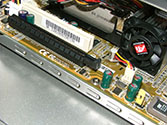








29 Comments
View All Comments
JarredWalton - Thursday, October 27, 2005 - link
Hopefully, anyone interested in the "promised" part 2 will find this post. I'm thinking of forgetting part 2 - I just have too much stuff to do! I've run some X2 benches/tests and can tell you this.The 330P, EQ3901-300P, SN25P, and ST20G5 all worked flawlessly with dual core - once the BIOS was updated. That last part is important, so let me elaborate.
For the 330P and ST20G5, the system WOULD NOT work with the BIOS I had (i.e. POST failed or complete system instability in the case of the 330P), so I had to switch back to a single core, update the BIOS, and then it worked. The 330P at first seemed to work, but I got frequent crashes and I couldn't even flash the BIOS with the X2 installed. If you have an extra 939 CPU, you should be fine; if you don't... well, I don't know if current 330Ps or ST20G5s are shipping with the latest BIOS or not, but I doubt it. (Ask Biostar/Shuttle for more information, I would suggest.)
Notably absent from the above list of X2 supported SFFs is the SN95G5v1/v2. I have v2, and it won't get past POST with an X2 processor. V3 will apparently work, but why buy an older AGP SFF these days? The Soltek worked fine, the SN25P was probably the best fit for the X2 plus a faster GPU, but the 330P was a lot more stable with the latest BIOS update. (The BIOS seemed to address several of the stability issues I had initially.) As far as I can tell, the USB + X2 issues of the SN25P have been resolved - I couldn't get any problems to occur, but then I may not be using the "right" USB device to cause a crash.
My pick overall remains with the SN25P. I successfully overclocked an X2 3800+ to 2.70 GHz in that system, where I could only reach 2.50 GHz in the 330P and 3901. Temperatures were a little lower than the 330P, cooling is better, but the system is larger. I'd say the 330P is now second overall in the recommendation list, and it does look pretty nice. The AGP units are not worth purchasing unless you can get them really cheap.
As nice as I think the ST20G5 looks, I feel the chipset used is complete garbage. Later ATI Xpress 200 chipsets (like the Crossfire stuff) are apparently much better, but the early Xpress 200 is at best equal to the like of ALi/ULi and SiS. Even VIA would be better (outside of integrated graphics performance) than the original Xpress 200. Overclocking remains essentially non-existent, and the smaller PSU (240W) will struggle with an X2 plus faster GPU. There's no way I would recommend spending $350 on the ST20G5.
Jarred Walton
SFF and Guide Editor
AnandTech.com
P.S. I'm skipping the 775 roundup as well, and will be moving on to later 775 systems for review. Basically, all of the 915/925 SFFs are outdated by the Pentium D, so there's no reason to purchase one (in my opinion). If you really want some brief thoughts on a specific 775 SFF, email me and I'll let you know. I have looked at several of the units, but putting together a 25000 word article on outdated hardware doesn't seem like a good use of time.
highlandsun - Tuesday, November 1, 2005 - link
Thanks for following up here, I just found this roundup while googling for ST20G5 reviews. My brother has an SN95G5v2 and we spent several hours one night trying to make it behave after updating to the latest BIOS. After the update Windows no longer saw his Logitech wireless trackball (but Linux still saw it just fine) plugged into the PS/2 port. We had to go back to the original BIOS that the thing shipped with. Unfortunately the original version doesn't support Cool'n'Quiet on the Winchester or Venice 3000+ that we plugged in (we had one of each), which was why we went looking for the BIOS upgrade in the first place.Anyway, he's using the SN95 for an HTPC, and I got interested in going the same route. But I was looking at the ST20 instead. The SN25P isn't a viable option because we're using Fusion HDTV tuner cards, and they're PCI only, no PCI-E version yet. I couldn't care less about AGP vs PCI-E for video in this case, as it's all overkill for simple media streaming. (The only key feature is making sure the video card supports DxVA for DVICO's MPEG decoder to work well.) But now it seems that none of Shuttle's current offerings are really suitable, since the ST20 really is too flawed in other areas.
Has anyone ever gotten an answer from Shuttle about why they would go to the trouble of using the Nforce3 Ultra but not using its integrated Gbit LAN??
dlevens - Sunday, September 4, 2005 - link
It would be nice to see a section on customer support. I have been extremely disapointed in Shuttle support for these SFF systems. I started with the SV25 and about 10 cubes later I am running the sn25p. I have to say I hate this thing. Also surprised to see there was no mention of some major issues with stability due to cheap or faulty sata cables. There are a ton of posts on sudhian about issues related to the sata cables. Curious if Anandtech saw any of these issues? http://forums.sudhian.com/messageview.aspx?catid=4...">http://forums.sudhian.com/messageview.a...amp;thre...Although, I would expect shuttle would send a well tested machine for a review site.
I also had a miserable time finding the most stable way to build the sn25p as far as drivers. Still not sure I have it right. This would be a great section to add in a review. I made a post here reguarding driver issues.
http://forums.sudhian.com/messageview.aspx?catid=4...">http://forums.sudhian.com/messageview.a...amp;thre...
One of my biggest complaints about the sn25p is sound. Was shocked to see the Via envy praised so much in the review. Maybe this is part of the driver issues I am having or could be the game I am currently playing, but sound is breaking up constantly on this thing. I have tried both drivers from VIA and both from shuttle. Anyone else playing Warlords IV on an sn25p and able to get your sound to work? I play warlords IV and run skype in the background for voice. Sound is garbled and breaks up.
Still looking for shuttle to be unseated in the sff market, would be nice to find some quality and stability to match the high price we pay for these sff systems. And a company who stands behind their product with great support would be icing on that cake.
Dennis
JarredWalton - Thursday, October 27, 2005 - link
Hey Dennis - I don't know if you'll see this, but I'll add it for others that might look. I obviously can't play all the games out there with each unit, so all I know is that the SN25P and the Via Envy did great on the tests I ran. The sound was also completely free of static, which is not the case for several of the others. The lack of static was far more important to me than other aspects of the sound system.Anyway, I didn't run into driver issues or SATA issues. I don't know if I just got lucky or what. I did a clean install of XP SP2, then I used the included CD to get sound and networking. I then downloaded the latest nF4 chipset drivers, along with graphics drivers for the ATI card I used, and I grabbed all the updates from Windows Update. Everything seemed to run fine.
artifex - Monday, August 22, 2005 - link
I think it'd be fun to compare these to Iwill's ZMAXdp, which is a dual-Opteron SFF. Not dual core, but dual processor. SFFTech says it's using nForce3 Pro as the chipset. It's also amazingly expensive, and has a silly little fin antenna :)JarredWalton - Thursday, August 25, 2005 - link
Iwill declined to send the current ZMAXdp when I emailed them, but they're working on an updated version for the future, so we'll see.Zak - Monday, August 15, 2005 - link
Frankly, each one of them has one single fault, just one, that makes, otherwise perfect box, useless for me... Some have the card readers up front that spoil the looks and I don't need them, some have no SPDIF out, some have 4 pin FireWire connectors, some are butt-ugly, some have on-board video. They'd be perfect otherwise if not for those single small problems. I haven't found a small factor case yet that would be perfect for me. So I'm sticking to towers for now.Zak
jopa25 - Saturday, August 13, 2005 - link
Hi, congratulations and thanks for that great review, in the first placeI'd have a little question about the the measurement of the noise levels of these SFF, is there any differences in the way noise was measured in relation with the former roundup (478/754 SFF roundup) ?
I expected the newer models to be quieter without GPU fan than the 478/754 SFF. However, according to the measurements, at 12 inches far, 4 out of the 5 478/754 SFF reviewed remained below 30dB, while the new models keep in a range from 37 to 46 dB in the same test. Quite a significant difference, isn't it?
As a part of an explanation, I guess the processor used in the last roundup (AMD Athlon 64 3800+ with Newcastle core) is not exactly wonderful at power saving, but should not be far from the Intel Pentium 4 3.0 used in the other roundup anyway.
So, the question is: Is there any reasonable explanation for these high levels of noise with fanless GPU, in comparison with those from the 478/754 roundup?
JarredWalton - Saturday, August 13, 2005 - link
I'm not entirely sure why the noise levels were higher. Part of it may be due to the time of year (winter vs. summer). The room that the systems were in was probably closer to 65 F for the last roundup, whereas I'd say close to 75 F for the current roundup. A 10 degree difference in room temperature would have a substantial impact, unfortunately. (If you compare the SN25P results to the March testing, it was substantially louder during stress testing.)I may not have measured in the exact same location relative to the last SFF roundup. I think I measured the socket 478 units from the front, which may have impacted things, and I moved some desks around which could have impacted scores as well. The rear of the SFFs are now closer to a wall than the old location, so noise reflecting off the wall might be changing the readings a bit.
I tried to be consistent with all the units in the roundup, but the use of differing CPUs makes it hard to say how they compare with the older models. I would say, however, that in typical use only the G5 units were at the same level as the last roundup. The 330P idled very low, but stress tests made it quite a bit louder. The SN25P and EQ3901 are both clearly louder than everything but the e-bot, which is roughly on the same level in terms of noise.
WooDaddy - Friday, August 12, 2005 - link
Jarod,GREAT Article. For quite some time I wanted to see a review with the SN25 and ST20 together. In the meantime, I bought a Mac Mini (quit screaming "traitor"). Out of curiousity, do you or anyone know the rated noise levels of the mini? It's dead quiet even at full CPU.
For you LGA775 SFF round-up, please don't forget to consider the Trigem Kloss PC (www.klosspc.com available at ZZF). Personally, it's the best looking SFF I've seen (better than the ASUS Spressos). I've been desperately looking for a review on that badboy.
Thanks